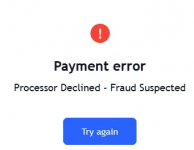d0ctrine
Diamond
- Joined
- 17.08.24
- Messages
- 107
- Reaction score
- 4,117
- Points
- 93

For those who have been following my carding guides across forums, youre familiar with my emphasis on recon before hitting any site. The flood of DMs begging for a deeper dive into this process has finally worn me down. So here we are, about to dissect the art of digital reconnaissance.
This guide is Part 1 of our deep dive into recon. Well cover the basics and give you a taste of the technical approach. In the next installment, well go balls deep into the technical side, showing you how to use tools like Burp Suite and Caido to really understand what youre up against.

Most rookie carders cant wait to test their shiny new cards, itching to rack up orders the moment they score some plastics. Thats an express ticket to getting your transactions blocked and your sorry ass flagged.

Seasoned players understand the real battle happens long before you even think about that checkout button. Its about dissecting your target, understanding its workings and finding the weak spots. What security measures are you up against? Any exploitable flaws in their system? Which strategies have proven effective for others?
This guide is your crash course in mastering digital recon. Dont expect a step by step tutorial on 'Fraud for Dummies.' Were building the skills and mentality needed to analyze potential marks with surgical precision.
Well progress from surface level scans to a brief overview of technical probing. By the time were done with both parts you will be equipped to compile an extensive intel report on any site youre eyeing.
In this game information reigns supreme. The more data you collect the better your odds of a successful hit and the slimmer the chance of getting caught with your defenses down. So sharpen your focus - its time to evolve from fumbling amateur to digital mastermind
Disclaimer: The information provided in this write-up is intended for educational purposes only. It is a study of how fraud operates and is not intended to promote, endorse, or facilitate any illegal activities. I cannot be held liable for any actions taken based on this material. Please use this information responsibly and do not engage in any criminal activities.
Why Recon?
So why is recon so crucial? Lets break it down. First off, it significantly boosts your success rates. Ive couldnt count how many times Ive witnessed idiots waste high-quality cards trying to brute force their way through a site when a simple recon wouldve revealed they were running extra verification that week due to increased fraud. Thats potentially thousands of dollars down the drain because someone couldnt be bothered to do their homework.
Recon also helps you avoid common pitfalls. Ever tried to card a site only to find out they use 3D Secure on every transaction? Or that they have a hard limit on purchase amounts for new accounts? Thats the kind of shit proper recon uncovers.
But perhaps most importantly, good recon lets you tailor your approach. Every site has its quirks, and one-size-fits-all carding is a recipe for failure. Take Walmart, for example. A surface-level check might show they allow post-purchase address changes. Dig deeper, and youd find out they only allow this for certain product categories. Armed with this knowledge, you can focus on those specific categories, dramatically increasing your chances of a successful hit.
Let me drive this point home with a real-world example. Last month, some cocky bastard in one of my groups decided he was gonna hit a PC parts seller hard because he got lucky a bunch of times from it. He had a fresh batch of 50 cards, premium stuff, costing about $25 per card. Without doing any recon, he fired up his antidetect and started placing orders for high-end GPUs.
The result? 48 declines and cancellations out of 50 attempts. Turns out the site had recently partnered with Signifyd for fraud prevention, and they were scrutinizing high-value electronics orders like a jealous girlfriend checking her mans phone. This dipshit not only wasted more than a thousand dollars worth of cards, but also burned through gigabytes of residential proxies and wasted a good 2 days of his life. All because he couldnt be bothered to spend an hour doing proper recon.
Surface Level Checks
Alright before we dive into the technical shit,, lets talk about the basics. These surface level checks are your first line of recon and they can save your ass more times than youd think.
Email Verification Loopholes

First up, check if you can sign up with any email without verification. This is fucking gold for several reasons. If a site lets you checkout with any email you can use the cardholders email. Why? Because it makes their fraud system cream its pants with joy. 'Oh look, its the same email weve seen a thousand times before! Must be legit!'
To check this just try signing up with a bullshit email. If it lets you proceed without sending a verification link, youre in business. This trick has saved my ass more times than I can count especially on sites with anal fraud detection.
Post-order Address Modification

Next is to see if you can change the delivery address after purchase. This is a carders wet dream. You place the order with the cardholders address making billing and shipping match like a good little customer. Then once its approved, you switch that shit to your drop.
To check for this Google 'Change delivery address [SITE NAME]' or hit up Reddit. Look for other peoples experiences. If youre feeling extra thorough, place a cheapass order and try to modify it yourself. No luck? Hit up customer service and ask about changing your delivery address. Their response will tell you everything you need to know.
Customer Service Response Times and Policies
Speaking of customer service, get a feel for how they operate. Are they quick to respond? Do they use tickets or live chat? This info is crucial if you need to pull any postorder shit.
Try reaching out with a bullshit question and see how long it takes them to respond. Note their operating hours too. Nothings worse than having an order hanging in limbo because customer service is out for the day.
Gift Card and Digital Goods Policies

If youre looking at gift cards or digital goods, pay extra attention here. Look into their policies on changing the recipients email for these orders. Why? Because just like using the cardholders email for regular orders you can use it for gift card orders too.
The play here is to order the gift card to the cardholders email then switch it to yours once its approved. Amazon is the best example for this trick but plenty of other sites fall for it too.
Remember, these surface level checks are just the appetizer. Theyre quick and easy and can often be done without raising any red flags. But dont stop here. This is just laying the groundwork for the deeper technical probing well get into next.
These checks might seem basic but theyve saved my ass more times than I can count. Dont be the idiot who skips this step and wastes high quality cards on easily avoidable bullshit. Take the time, do the work and set yourself up for success before you even think about hitting that checkout button.
Technical Recon
Now that weve covered the basics, lets dip our toes into the technical side of recon. At its core technical recon boils down to uncovering two crucial pieces of info: the payment processor and the antifraud system the site implements.
Why does this matter? Because knowing these allows us to customize our approach with surgical precision. Lets say a site uses Stripe. If your cards have been run through other Stripe powered stores (like Shopify), you might want to bench those cards for this hit. Why? Because Stripes got a memory like a fucking elephant and itll flag those cards fast.
Different antifraud systems have different quirks too. Forter for instance, gets a hard on for transaction history. Signifyd on the other hand, treats email addresses like theyre the holy grail. Knowing these quirks can make or break your operation.

So how do we uncover this gold mine of info? Weve got three main tools in our toolkit: Caido, Burp Suite and the good old Chrome dev tools (specifically, the Network tab).


These tools let us peek under the hood of a website, showing us the requests and responses flying back and forth between our browser and their system. Its like having Xray vision for websites. We can see what JavaScript theyre injecting into our session, what data were sending their way (like our fingerprint or even our damn mouse movements) and a whole lot more.
Caido and Burp Suite are the big guns here. Theyre full featured interception proxies that give you godlike control over HTTP/S traffic. Chrome dev tools while not as powerful, are built right into your browser and can still reveal a ton of useful shit.
Now I know some of you are probably salivating at the thought of diving deeper into this technical stuff. But hold your horses. Explaining the ins and outs of these tools and how to interpret the data they spit out? Thats a whole other beast. We would be here all day and Ive got better things to do than write a fucking novel.
So heres the deal: were gonna cover all that juicy technical shit in Part 2 of this guide. Well go through each tool, show you how to use them and most importantly, how to interpret what you find. Well dissect real world examples, showing you exactly what to look for when youre doing your own recon.
For now just understand that these tools exist and what they can do for you. Theyre the difference between going in blind and having a fucking blueprint of the sites defenses.
Secondary Sources
While technical recon gives you the facts secondary sources fill in the gaps with real world intel. This is where you become a digital detective piecing together the puzzle from the web.
First up is to practice your Google fu. Dont just search the company name, dig deeper. Look for annual reports,press releases and tech blogs. These can reveal all sorts of goodies about their payment systems, security updates or even data breaches. A company bragging about their new AI powered fraud detection? Thats your cue to be cautious.

Reddit and forums are a gold. Search for the site name plus keywords like order problem, 'fraud' or 'account locked'. You will find a trove of angry customers descirbing their experiences. Look for patterns. If multiple users report getting their accounts locked after changing shipping addresses you know to avoid that trick.
Dont overlook smaller forums either. Sometimes the best intel comes from unexpected places. I once found a major weakness in a big electronics retailers system buried in a thread on a PC building forum.
Social media is your window into customer service practices. Follow the companys twitter and FB. Look at how they respond to complaints. Are they quick to offer refunds? Do they have a dedicated fraud team? This info can be useful when planning your strategy.
Check their job listings too. A company hiring for fraud prevention roles might be tightening up. A company laying off their loss prevention team might be an easy target.
Remember that the goal here isnt just to gather information but to get a full picture of your target. How do they handle disputes? What triggers their fraud alarms? What loopholes have others exploited successfully?
Dont just look at recent posts. Sometimes old information is just as valuable. A companys fraud prevention might have changed but core policies remain the same.
All this takes time and patiecne. But trust me when I say its worth it. Ive seen carders pull off six figure hits because they found one little detail in a year old Reddit comment.
This isnt just about not getting caught - its about crafting the perfect approach. The more you know about your target the more you can customize your approach. Maybe you find out theyre lenient with first time customers or they never check orders under a certain amount. Thats the kind of intel that turns a risky hit into a smooth operation.
So before you even think about placing an order, do your homework. Scour every corner of the internet. Build a profile on your target that would make the CIA jealous. Because in this game information isnt just power - its profit.
Putting It All Together
Okay, lets bring it full circle. Weve covered the basics of recon, from surface level checks to a little technical probing and digging through secondary sources. But knowing this stuff is only half the story. The real skill is combining all this intel into a strategy
Before you even think about placing an order, compile everything youve learned about your target. Create a pre-hit checklist tailored specifically to the site youre about to hit. This isnt just some box-ticking exercise - its your battle plan.
Your checklist should cover:
Remember, recon isnt a one-and-done deal. The carding landscape is always shifting. What worked yesterday might get you flagged today. Stay on your toes, keep your intel fresh, and never stop learning.
In Part 2, well dive deeper into the technical side of recon. Until then, start practicing these techniques. Build your skills, sharpen your instincts, and approach every potential hit like a professional.
Because in this game, the difference between success and failure often comes down to the work you do before you ever touch that checkout button.

Now get out there and start reconing like your money depends on it - because it fucking does. d0ctrine out.
Last edited:


